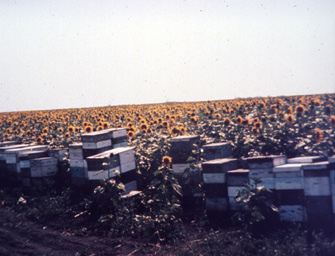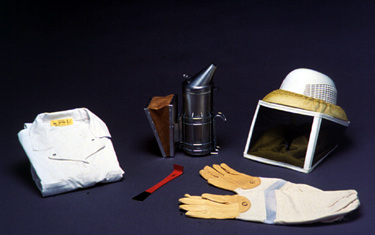
Since they first tasted honey, people have been fascinated by bees. For thousands of years most of the activities of honey bees remained hidden in their nests, which were in dark, hollow places in trees with small entrance holes. Humans raided the nests for their honey, but otherwise didn't know much about the bees.
Over time people learned how to take care of honey bees. The first beekeepers kept their bees in hollowed-out logs or clay pots, hanging high in a tree away from predators. Today, beekeepers place their honey bees in white, wooden boxes, or hives neatly spaced and lined up in their apiary, or beeyard.

Keeping bees can be a rewarding hobby or a full-time business. People keep bees for different reasons, such as for honey and beeswax, for their ability to serve as pollinators of crops, or simply for the fun of learning more about these interesting and complex in sects. Some beekeepers raise queens to sell to other beekeepers, like a farmer may sell a prize sow or bull.
Almost anyone can keep bees. However, always be aware the main problem with keeping bees is that they have the ability to sting. To start out, a beekeeper must find a suitable location, gather the proper equipment, and find a source of bees. It is always a good idea to learn as much as possible about bees and beekeeping from experts and books before you get started.
Professional beekeepers recommend purchasing new hive boxes and frames or making your own in a standard size. Purchasing secondhand equipment can lead to problems because it may be contaminated with various bee diseases or may not be a standard size and thus lead to problems later if you want to expand.
There are several different ways of starting a bee colony. Most beginners start by buying package bees available from suppliers. Beekeepers may also buy a nucleus colony (nuc) or an established colony. Experienced beekeepers may collect wild swarms or colonies. However, current problems with diseases or parasites like varroa mites that kill bees, or with harder to manage bees like Africanized honey bees, make the chances of finding a healthy, easy to manage wild swarm less and less likely.
To remove honey from a hive, the beekeeper must have the right equipment for the job. When working the bees, the beekeeper wears a veil to keep bees from stinging the head and face. Many beekeepers will also wear a white bee suit. Depending on the colony, the beekeeper may wear heavy leather gloves to protect his or her hands.
Beekeepers usually have a smoker, filled with straw or wood chips. The beekeeper blows a bit of smoke at the bees. The smoke confuses and calms the bees while the beekeeper takes some honey away.
To remove the honey, the beekeeper pulls out the wooden frames, which are the foundation to support the wax comb. The beekeeper uses a hive tool to pry the frames apart.
Some beekeepers put bees into glass hives so they can show their busy bees to students or others interested in bee biology. This is called an observation hive.
Beekeepers may also rent their bees to farmers to pollinate crops. The bee hives are moved into or nearby the field when the crop is about to flower and is removed again once the crop has finished flowering. Watermelons, cantaloupes and cucumbers are just a few of the crops that require honey bees for pollination.
